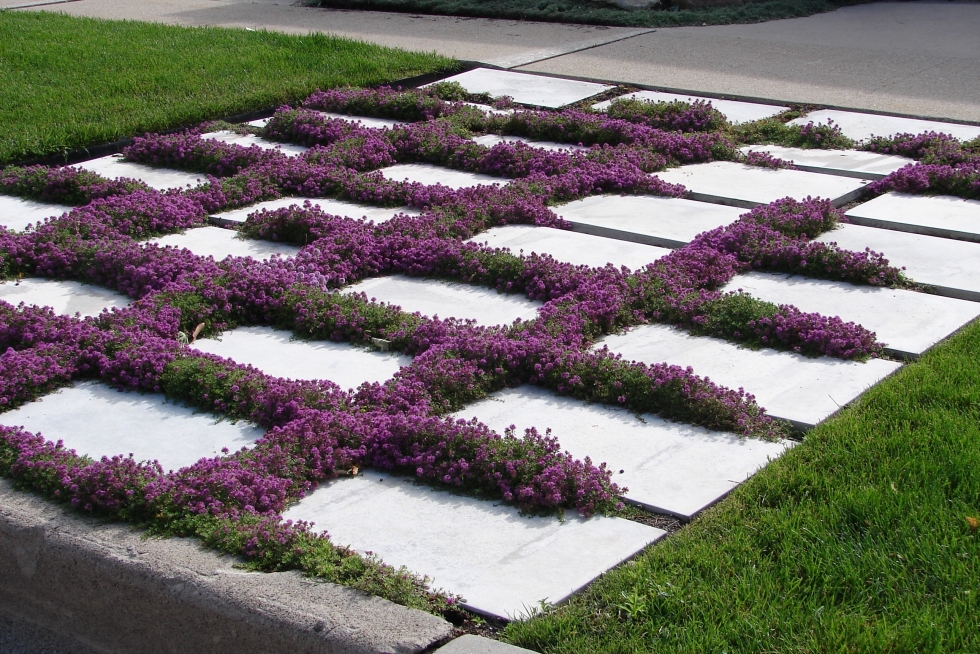The Aggressive Nature of Creeping Thyme
Creeping thyme, a popular, low-maintenance groundcover, has gained widespread recognition for its ability to spread quickly and effortlessly. This aggressive growth habit, while beneficial for filling gaps and creating a lush landscape, can also lead to concerns about its potential to overtake grass. As a result, many homeowners and landscapers wonder: will creeping thyme take over grass? Understanding the nature of creeping thyme is crucial in determining the likelihood of it dominating grassy areas. With its ability to spread rapidly, creeping thyme can quickly fill in gaps between pavers, stones, and other hardscapes, making it an ideal choice for areas with poor soil quality or heavy foot traffic. However, this same aggressive growth habit can also lead to concerns about its potential to choke out grass, especially in areas with poor lawn care or favorable climate conditions.
How to Contain Creeping Thyme and Prevent Grass Takeover
To prevent creeping thyme from taking over grass, it’s essential to implement strategies that contain its spread. One effective method is to use physical barriers, such as plastic or metal edging, to separate the creeping thyme from the grass. Mulching around the creeping thyme plants can also help suppress grass growth and prevent the thyme from spreading. Regular pruning is another crucial step in containing creeping thyme. By trimming back the thyme plants regularly, you can prevent them from producing seeds and reduce their ability to spread. Additionally, maintaining a healthy lawn through regular mowing, watering, and fertilizing can help prevent creeping thyme from taking over. By taking these proactive steps, you can enjoy the benefits of creeping thyme while preventing it from dominating your grass.
Creeping Thyme vs. Grass: A Comparison of Growth Habits
When considering the potential for creeping thyme to take over grass, it’s essential to understand the growth habits of both plants. Creeping thyme, a low-growing, spreading groundcover, can quickly fill in gaps and cover large areas. In contrast, grass grows upright and typically requires regular mowing to maintain a neat appearance. The aggressive growth habit of creeping thyme allows it to outcompete grass in areas with poor soil quality or inadequate lawn care. Additionally, creeping thyme can thrive in poor soil conditions, whereas grass often requires well-draining soil and regular fertilization. However, grass has a competitive advantage in areas with regular mowing and watering, as these practices can help suppress the spread of creeping thyme. Understanding the differences in growth habits and competitive advantages is crucial in determining whether creeping thyme will take over grass in a given area.
The Benefits of Creeping Thyme as a Lawn Alternative
While concerns about creeping thyme taking over grass are valid, this low-maintenance groundcover also offers several benefits as a lawn alternative. One of the most significant advantages of creeping thyme is its drought tolerance, making it an ideal choice for areas with water restrictions or dry climates. Additionally, creeping thyme requires minimal maintenance, eliminating the need for regular mowing, fertilizing, and pest control. This groundcover can also thrive in poor soil conditions, making it a great option for areas with compacted or nutrient-depleted soil. Furthermore, creeping thyme is a natural weed suppressor, reducing the need for herbicides and other chemicals. By understanding the benefits of creeping thyme as a lawn alternative, homeowners can make informed decisions about whether to use this groundcover in their landscaping designs, and how to manage its spread to prevent it from taking over their grass.
When to Expect Creeping Thyme to Take Over Grass
While creeping thyme can be a valuable addition to a landscape, it’s essential to understand the conditions under which it’s most likely to overtake grass. In areas with poor soil quality, creeping thyme’s ability to thrive in challenging conditions can give it a competitive advantage over grass. Additionally, inadequate lawn care practices, such as infrequent mowing or watering, can create an environment in which creeping thyme can spread quickly. Favorable climate conditions, such as warm temperatures and high humidity, can also contribute to the rapid spread of creeping thyme. Homeowners who neglect to maintain their lawns or live in regions with ideal creeping thyme growth conditions may find themselves asking, “Will creeping thyme take over my grass?” By understanding these factors, homeowners can take proactive steps to prevent creeping thyme from overtaking their grass and maintain a balanced landscape.
Preventing Creeping Thyme from Choking Out Grass
To prevent creeping thyme from overtaking grass, it’s essential to promote healthy grass growth through regular maintenance practices. One of the most critical steps is to maintain a regular mowing schedule, as this will help to keep grass at a healthy height and prevent creeping thyme from spreading. Additionally, proper watering and fertilizing are crucial for promoting healthy grass growth. By providing grass with the necessary nutrients and water, homeowners can create an environment in which grass can thrive and compete with creeping thyme. It’s also important to address any underlying issues, such as poor soil quality or inadequate drainage, which can contribute to the spread of creeping thyme. By taking these proactive steps, homeowners can reduce the likelihood of creeping thyme taking over their grass and create a balanced landscape. Remember, the key to preventing creeping thyme from choking out grass is to stay vigilant and maintain a healthy, well-manicured lawn.
Coexisting with Creeping Thyme: A Balanced Approach
While creeping thyme can be a formidable opponent for grass, it’s not necessarily a zero-sum game. With a balanced approach, homeowners can create a harmonious landscape design that incorporates both plants. By understanding the growth habits and competitive advantages of each, it’s possible to design a landscape that leverages the strengths of both creeping thyme and grass. For example, using creeping thyme as a groundcover in areas with poor soil quality or heavy foot traffic can help to reduce maintenance requirements and create a more sustainable landscape. Meanwhile, grass can be used in areas with better soil quality and more favorable growing conditions. By striking a balance between these two plants, homeowners can create a beautiful and functional landscape that minimizes the risk of creeping thyme taking over. Remember, the key to coexisting with creeping thyme is to understand its strengths and weaknesses and design a landscape that plays to the strengths of both plants. With a little creativity and planning, it’s possible to create a landscape that will thrive for years to come, without worrying about the question of “will creeping thyme take over my grass.”
Conclusion: Managing the Spread of Creeping Thyme
In conclusion, the question of “will creeping thyme take over grass” is a valid concern for homeowners who are considering using this popular groundcover in their landscaping. However, by understanding the growth habits and competitive advantages of both creeping thyme and grass, it’s possible to design a landscape that minimizes the risk of takeover. By implementing responsible landscaping practices, such as regular pruning, mulching, and fertilizing, homeowners can create a balanced and harmonious landscape that incorporates the benefits of both plants. Remember, proactive management is key to preventing creeping thyme from taking over grass, and with a little creativity and planning, it’s possible to create a beautiful and functional landscape that will thrive for years to come. By following the tips and strategies outlined in this article, homeowners can enjoy the benefits of creeping thyme while keeping their grass healthy and thriving.



:max_bytes(150000):strip_icc()/types-of-creeping-thyme-2132329_05-ddf741097eaf4b50992c20fb46800aef.jpg)




